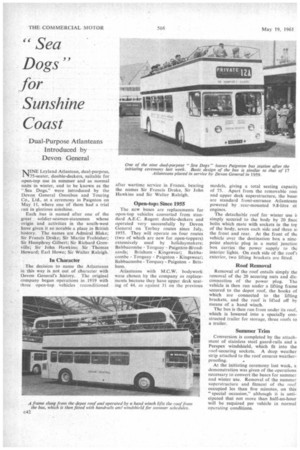"Sea Dogs" for Sunshine Coast
Page 80

If you've noticed an error in this article please click here to report it so we can fix it.
Dual-Purpose Atlanteans Introduced by Devon General
"MINE Leyland Atlantean, dual-purpose, 175-seater, double-deckers, suitable for open-top use in summer and as normal units in winter, and to be known as the "Sea Dogs," were introduced by the Devon General Omnibus and Touring Co., Ltd., at a ceremony in Paignton on May 11, where one of them had a trial rim in glorious sunshine.
Each bus is named after one of the great soldier-seamen-statesmen whose origin and activities in the south-west have given it so notable a place in British history. The names are Admiral Blake; Sir Francis Drake; Sir Martin Frobisher; Sir Humphrey Gilbert; Sir Richard Grenville; Sir John Hawkins; Sir Thomas Howard; Earl Howe; Sir Walter Raleigh.
In Character
The decision to name the Atlanteans in this way is not out of character with Devon General's history. The original company began operations in 1919 with three open-top vehicles reconditioned
after wartime service in France, bearing the names Sir Francis Drake, Sir John Hawkins and Sir Walter Raleigh.
Open-topi Since 1955
The new buses are replacements for open-top vehicles converted from standard A.E.C. Regent double-deckers and operated very successfully by Devon General on Torbay routes since July, 1955. They will operate on four routes (Iwo of which are new for open-toppers) extensively used by holidaymakers; Babbacombe Torquay Paignton-Broadsands; Brixham Kingswear; Babbacombe Torquay Paignton Kingswear; Babbacombe Torquay Paignton Brixham.
Atlanteans with M.C.W. bodywork were chosen by the company as replacements because they have upper deck seating of 44, as against 31 on the previous
models, giving a total seating capacit3 of 75. Apart from the removable roof and upper deck superstructure, the buse: are standard front-entrance Atlanteans powered by rear-mounted 9.8-litre oi engines.
The detachable roof for winter use it simply secured to the body by 20 fixer bolts which mate with sockets in the tor of the body, seven each side and three al the front and rear. At the front of tht vehicle over the destination box a nine
point electric plug in a metal junction box carries the power supply to tit( interior lights. On each side of the roof's exterior, two lifting brackets are fitted.
Roof Removal
Removal of the roof entails simply the removal of the 20 securing nuts and disconnection of the power plug. The vehicle is then run under a lifting frame secured to the depot roof, the hooks of which are connected to the lifting brackets, and the roof is lifted off by means of a hand winch.
The bus is then run from under its roof, which is lowered into a specially constructed trailer for storage, three roofs to a trailer.
Summer Trim
Conversion is completed by the attachment of stainless steel guard-rails and a Perspex windshield, which fit into the roof-securing sockets. A deep weather strip attached to the roof ensures weatherproofing.
At the initiating ceremony last week, a demonstration was given of the operations necessary to convert the buses for summer and winter use. Removal of the summer superstructure and fitment of the roof occupied les than five minutes, on this "special occasion," although it is anticipated that not more than hall-an-hour will be required per vehicle in normal operating conditions.




























































































































